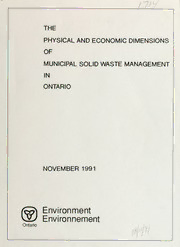
The Physical and economic dimensions of municipal solid waste management in Ontario : report PDF
Preview The Physical and economic dimensions of municipal solid waste management in Ontario : report
THE PHYSICAL AND ECONOMIC DIMENSIONS OF MUNICIPAL SOLID WASTE MANAGEMENT IN ONTARIO NOVEMBER 1991 Environment Environnement Ontario i /^ , ISBN 0-7729-8952-4 THE PHYSICAL AND ECONOMIC DIMENSIONS OF MUNICIPAL SOLID WASTE MANAGEMENT IN ONTARIO Report prepared for: Fiscal Planning and Economic Analysis Branch Ontario Ministry ofthe Environment NOVEMBER 1991 POINTEDON RECYCltDPAPtB IMPRIMCSUR DUPtPIEKRECVCIi Cette publication technique n'est disponible qu'en anglais. Copyright: Queen's Printer forOntario, 1991 This publication may be reproduced for non-commercial purposes with appropriate attribution. PIBS 1714 ACKNOWLEDGEMENT AND DISCLAIMER This report was prepared for the Ontario Ministry of the Environment as part of a Ministry-funded project. The views and ideas expressed in this report are those of the author and do not necessarily reflect the views and policies of the Ministry of the Environment, nor does mention of trade names or commercial products constitute endorsement or recommendation for use. (c) 1991 Her Majesty the Queen in Right of Ontario as represented by the Minister of the Environment TABLE OF CONTENTS Section Pfe ABSTRACI 1 1-1 1-1 1-1 1-1 2-1 2-1 2-7 2-10 2-10 2-11 2-11 2-13 2-13 2-14 WASTE GENERATION AND DISPOSAL PATHWAYS 3-1 3.1 General 3-1 3.2 Residential Solid Waste 3-1 3.2.1 Composition Data 3-1 3.2.2 Comparison of Residential Waste Composition Data Sources 3-3 3.2.3 Residential Solid Waste Quantities 3-7 3.3 Industrial/Commercial/Institutional Solid Waste 3-17 3.3.1 Materials Excluded from Estimated 3-17 3.3.2 Objectives of ICI Waste Generation Estimates 3-17 3.3.3 ICI Waste Composition Data 3-18 3.3.4 ICI Waste Quantity Estimates 3-22 3.3.5 Comparison ofCH2M HILL/ERL Model Estimated With RIS Estimates 3-27 3.4 Residential Waste Recycled 3-29 3.4.1 Background 3-29 3.4.2 Data Manipulation 3-30 3.4.3 Quantities of Residential Waste Recycled 3-32 TABLE OF CONTENTS Section Page 3.5 ICI Waste Recycled 3-33 3.5.1 Background 3-33 3.5.2 Data Availability and Limitations 3-42 PHYSICALAND ECONOMIC DIMENSIONS OF THE WASTE 4. MANAGEMENT SYSTEM 4-1 4.1 General Description ofthe System 4-1 4.2 LandfiUs 4-1 4.2.1 General Description 4-1 4.2.2 Physical Dimensions 4-6 4.2.3 Economic Dimensions 4-8 4.2.4 Future Trends 4-14 4.3 Incinerators 4-19 4.3.1 General Description 4-19 4.3.2 Physical Dimensions 4-19 4.3.3 Economic Dimensions 4-22 4.3.4 Future Trends 4-23 4.4 Transfer Stations 4-23 4.4.1 General Description 4-23 4.4.2 Physical Dimensions 4-24 4.4.3 Economic Dimensions 4-24 4.4.4 Future Trends 4-27 4.5 Haulers 4-30 4.5.1 General Description 4-30 4.5.2 Physical Dimensions 4-31 4.5.3 Economic Dimensions 4-45 4.5.4 Future Trends 4-49 4.6 Environmental Protection Industry 4-52 4.6.1 General Description 4-52 4.6.2 Physical Dimensions 4-55 4.6.3 Economic Dimensions 4-55 4.6.4 Future Trends 4-58 TABLE OF CONTENTS Pie Section PHYSICALAND ECONOMIC DIMENSIONS OF WASTE RECYCLING 5-1 5.1 General 5-1 5.2 Recycling Programs 5-1 5.2.1 The History of Recycling in Ontario 5-1 5.2.2 Physical Dimensions 5-3 5.2.3 Economic Dimensions 5-4 5.2.4 Future Trends 5-22 5.3 Materials Recovery Facilities 5-26 5.3.1 General Description 5-26 5.3.2 Physical Dimensions 5-27 5.3.3 Economic Dimensions 5-29 5.4.4 Future Trends 5-29 5.4 Private and Third Sector Recycling Agents 5-33 5.4.1 General Description 5-33 5.4.2 Physical Dimensions 5-34 5.4.3 Economic Dimensions 5-43 5.4.4 Future Trends 5-43 EXECUTIVE SUMMARY 6-1 6.1 LIST OF TABLES Pie Table 2.1 List ofWaste Management Master Plans WMMPs Review During MSW Dimensions 2-3 MSW 2.2 Secondary Data Sources Used in Database Dimensions Study 2-4 MSW 2.3 Waste Categories to be Used Throughout Dimensions Study 2-6 2.4 Aggregation of Industrial/Commercial/Institutional MSW Establishments Into 25 Input Matrix Categories for Dimensions Study 2-8 3.1 Re-grouping ofWaste Descriptions Used in Other Studies into General Waste Categories 3-4 3.2 Comparison ofWaste Composition and Generation Rates Found in Other Studies to Gore & Storrie (1990) Results 3-5 3.3 Estimated Residential Waste Composition in Ontario in 1987 and 1989 3-8 3.4 Estimated Residential Waste Generation by Material Type in Ontario in 1987 and 1989 3-10 3.5 Summary ofModifications to Residential Solid Waste Quantity Estimates 3-13 3.6 Estimated Residential Populations, Generation Rates and Waste Quantities Produced by County in Ontario, in 1987 and 1989 3-15 3.7 Aggregation of Industrial/Commercial/Institutional Activities Into 25 Input Matrix Categories (IMCs) 3-19 3.8 Summary ofAvailable Information and Waste Composition and Generation Rates by Industrial Sector 3-22 3.9 Estimated ICI Waste Quantities Generated in Ontario by Waste Component in 1987 and 1989 (CH2M HILL/ERL Model) 3-24 IV
